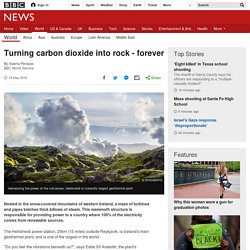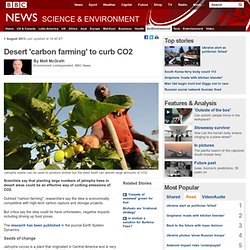

Turning carbon dioxide into rock - forever. Image copyright G Svanberg Nested in the snow-covered mountains of western Iceland, a maze of turbines and pipes belches thick billows of steam.

This mammoth structure is responsible for providing power to a country where 100% of the electricity comes from renewable sources. The Hellisheidi power station, 25km (15 miles) outside Reykjavik, is Iceland's main geothermal plant, and is one of the largest in the world. "Do you feel the vibrations beneath us? ", says Edda Sif Aradottir, the plant's manager, splashing snow as she stomps her boot on the ground. Image copyright A Saeberg "This is a volcanic area. Hellisheidi is not just an accomplished provider of green energy. Thus keeping this greenhouse gas out of the atmosphere and putting a dent in global warming. We have already reached the tipping point for CO2 levels in the atmosphere and extreme events will happen if we don't act quickly and apply every solution available" ____________ Edda Sif Aradóttir, CarbFix Making soda Porous rock Prof.
Tidal lagoon: £1.3bn Swansea Bay project to be backed. Carbon nanofibres made from CO2 in the air - BBC News. Scientists in the US have found a way to take carbon dioxide (CO2) from the air and make carbon nanofibres, a valuable manufacturing material.

Their solar-powered system runs a small current through a tank filled with a hot, molten salt; the fluid absorbs atmospheric CO2 and tiny carbon fibres slowly form at one of the electrodes. It currently produces 10g per hour. The team says it can be "scaled up" and could have an impact on CO2 emissions, but other researchers are unsure. Nonetheless, the approach offers a much cheaper way of making carbon nanofibres than existing methods, according to Prof Stuart Licht of George Washington University. "Until now, carbon nanofibres have been too expensive for many applications," he told journalists at the autumn meeting of the American Chemical Society in Boston. The question is whether the "one-pot" reaction demonstrated by Prof Licht and his team could help to drop that cost. But Prof Licht is confident his design can succeed. Norway to develop fish food from captured carbon dioxide. 16 July 2014Last updated at 03:46 ET By Matt McGrath Environment correspondent, BBC News A project that turns captured carbon dioxide into food for farmed fish is to be tested in Norway.

It involves producing Omega-3 fatty acids from algae that will be grown in a stream of CO2 at a test facility. At present the oil is produced for aquaculture from low value fish or krill caught in the waters of Antarctica But the new technique could absorb the gases responsible for global warming while providing sustainable fish food. Seafood is Norway's second largest export after oil and gas, valued at over $10b in 2013. The fjords produce around 60% of all the farmed Atlantic salmon in the world. Business is booming with the world's appetite for aquaculture showing little evidence of a slowdown. Nasa satellite to seek 'missing carbon' 30 June 2014Last updated at 12:29 ET By Jonathan Amos Science correspondent, BBC News Artist's impression: The satellite weighs about 455kg and will initially operate for two years The US space agency (Nasa) will make a second attempt on Tuesday to put a high-resolution carbon dioxide observatory in orbit.

The first satellite was destroyed on launch in 2009. Since then, scientists and engineers have built a near identical spacecraft, which will launch from the Vandenberg Air Force Base in California. "It's been a long walk back to where we are now," David Crisp, the mission's Science Team Leader, told BBC News. "We've delivered the spacecraft, but we've still got a number of challenging steps ahead of us before this system is on orbit, operating and returning science data. " The Orbiting Carbon Observatory-2 (OCO-2) will ride to orbit on a Delta II rocket Lift-off is timed for a 30-second window at 02:56 local time (09:56 GMT; 10:56 BST). European forests near 'carbon saturation point' Household Energy Consumption in England and Wales, 2005–11. Desert 'carbon farming' to curb CO2. 1 August 2013Last updated at 10:45 ET By Matt McGrath Environment correspondent, BBC News Jatropha seeds can be used to produce biofuel but the plant itself can absorb large amounts of CO2 Scientists say that planting large numbers of jatropha trees in desert areas could be an effective way of curbing emissions of CO2.

Dubbed "carbon farming", researchers say the idea is economically competitive with high-tech carbon capture and storage projects. But critics say the idea could be have unforeseen, negative impacts including driving up food prices. The research has been published in the journal Earth System Dynamics. Seeds of change Jatropha curcas is a plant that originated in Central America and is very well adapted to harsh conditions including extremely arid deserts. It is already grown as a biofuel in some parts of the world because its seeds can produce oil. Continue reading the main story “Start Quote End QuoteProf Klaus BeckerUniversity of Hohenheim "It is still somebody else's land.